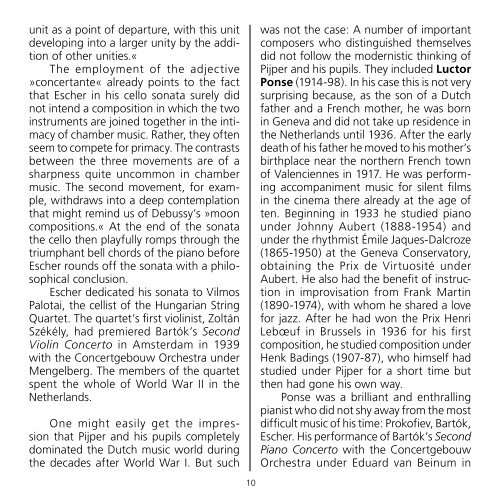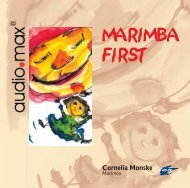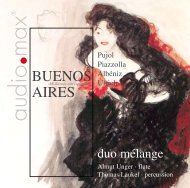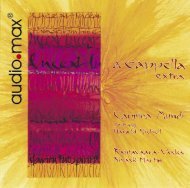Dutch Cello Sonatas - MDG Dabringhaus und Grimm
Dutch Cello Sonatas - MDG Dabringhaus und Grimm
Dutch Cello Sonatas - MDG Dabringhaus und Grimm
Erfolgreiche ePaper selbst erstellen
Machen Sie aus Ihren PDF Publikationen ein blätterbares Flipbook mit unserer einzigartigen Google optimierten e-Paper Software.
unit as a point of departure, with this unit<br />
developing into a larger unity by the addition<br />
of other unities.«<br />
The employment of the adjective<br />
»concertante« already points to the fact<br />
that Escher in his cello sonata surely did<br />
not intend a composition in which the two<br />
instruments are joined together in the intimacy<br />
of chamber music. Rather, they often<br />
seem to compete for primacy. The contrasts<br />
between the three movements are of a<br />
sharpness quite uncommon in chamber<br />
music. The second movement, for example,<br />
withdraws into a deep contemplation<br />
that might remind us of Debussy’s »moon<br />
compositions.« At the end of the sonata<br />
the cello then playfully romps through the<br />
triumphant bell chords of the piano before<br />
Escher ro<strong>und</strong>s off the sonata with a philosophical<br />
conclusion.<br />
Escher dedicated his sonata to Vilmos<br />
Palotai, the cellist of the Hungarian String<br />
Quartet. The quartet’s first violinist, Zoltán<br />
Székély, had premiered Bartók’s Second<br />
Violin Concerto in Amsterdam in 1939<br />
with the Concertgebouw Orchestra <strong>und</strong>er<br />
Mengelberg. The members of the quartet<br />
spent the whole of World War II in the<br />
Netherlands.<br />
One might easily get the impression<br />
that Pijper and his pupils completely<br />
dominated the <strong>Dutch</strong> music world during<br />
the decades after World War I. But such<br />
was not the case: A number of important<br />
composers who distinguished themselves<br />
did not follow the modernistic thinking of<br />
Pijper and his pupils. They included Luctor<br />
Ponse (1914-98). In his case this is not very<br />
surprising because, as the son of a <strong>Dutch</strong><br />
father and a French mother, he was born<br />
in Geneva and did not take up residence in<br />
the Netherlands until 1936. After the early<br />
death of his father he moved to his mother’s<br />
birthplace near the northern French town<br />
of Valenciennes in 1917. He was performing<br />
accompaniment music for silent films<br />
in the cinema there already at the age of<br />
ten. Beginning in 1933 he studied piano<br />
<strong>und</strong>er Johnny Aubert (1888-1954) and<br />
<strong>und</strong>er the rhythmist Émile Jaques-Dalcroze<br />
(1865-1950) at the Geneva Conservatory,<br />
obtaining the Prix de Virtuosité <strong>und</strong>er<br />
Aubert. He also had the benefit of instruction<br />
in improvisation from Frank Martin<br />
(1890-1974), with whom he shared a love<br />
for jazz. After he had won the Prix Henri<br />
Lebœuf in Brussels in 1936 for his first<br />
composition, he studied composition <strong>und</strong>er<br />
Henk Badings (1907-87), who himself had<br />
studied <strong>und</strong>er Pijper for a short time but<br />
then had gone his own way.<br />
Ponse was a brilliant and enthralling<br />
pianist who did not shy away from the most<br />
difficult music of his time: Prokofiev, Bartók,<br />
Escher. His performance of Bartók’s Second<br />
Piano Concerto with the Concertgebouw<br />
Orchestra <strong>und</strong>er Eduard van Beinum in<br />
Luctor Ponse in 1938<br />
(Privatsammlung)<br />
10 11<br />
1946 is legendary. His recording of Bartók’s<br />
Sonata for Two Pianos and Percussion with<br />
Géza Frid and members of the London Symphony<br />
Orchestra <strong>und</strong>er Antál Dorati in 1960<br />
has been re-released on compact disc.<br />
While Ponse shared with Escher Latin<br />
clarity in the design of form, his manner<br />
of composing stands out above all for its<br />
flawless structural intuition and the absence<br />
of any sort of systematic thinking. These<br />
characteristics continued to be the principal<br />
features of his music even when he turned<br />
to twelve-tone technique 1949, following<br />
an encounter with the Schönberg pupil<br />
Max Deutsch, and later ventured into the<br />
field of electronic music.<br />
During his »first period« Ponse composed<br />
chamber compositions to the exclusion<br />
of other genres: the Sonata for Two<br />
Violins in 1940, the Trio for Flute, Clarinet,<br />
and Bassoon and First String Quartet in<br />
1941, the First <strong>Cello</strong> Sonata and Deux<br />
pièces for Wind Quintet in 1943, the Duo<br />
for Violin and <strong>Cello</strong> in 1946, the Second<br />
String Quartet in 1947, the Violin Sonata in<br />
1948, and the Third String Quartet in 1949.<br />
Donemus published the First <strong>Cello</strong> Sonata<br />
in 1948. The earliest known performance<br />
of this work occurred in 1947 with the<br />
Belgian cellist Jean Aerts with the pianist<br />
Marthe Devos in Brussels; a performance<br />
in Antwerp with Luctor Ponse himself followed<br />
shortly thereafter.<br />
The sonata is quite classical and, in







